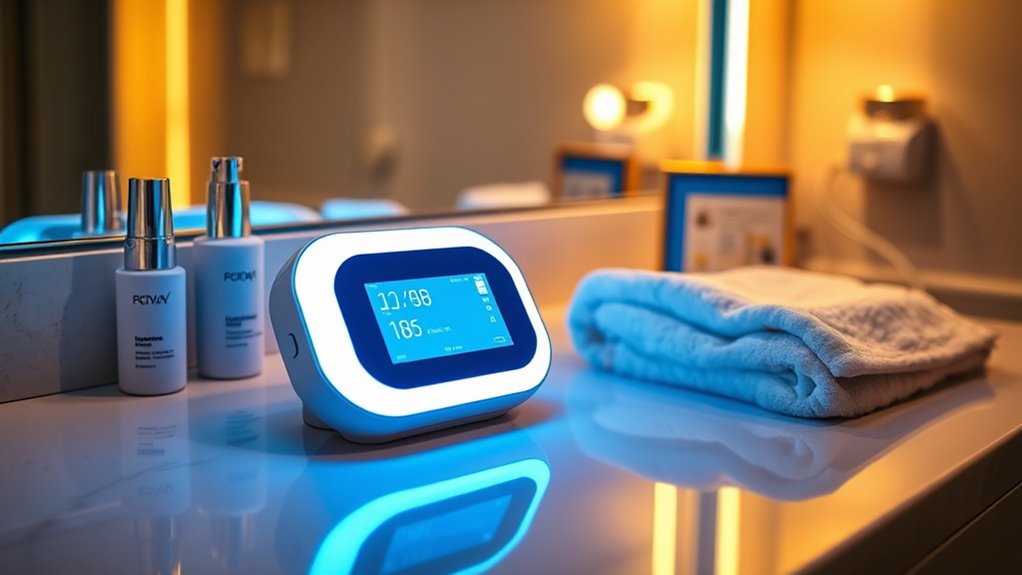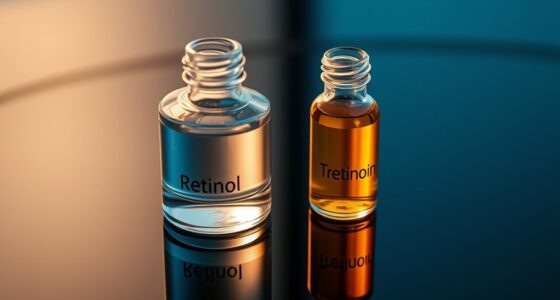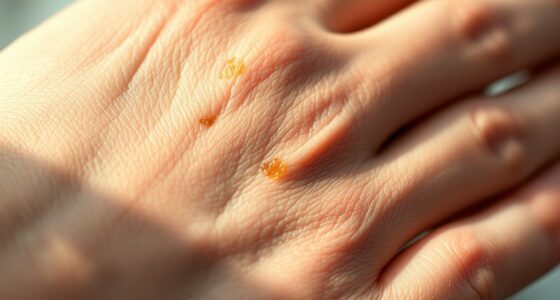Science shows that at-home radiofrequency devices can help improve skin firmness and elasticity by stimulating collagen production, but their effects are generally milder and take longer to appear than professional treatments. These devices use lower energy levels, so results are subtle and vary based on device quality and consistent use. Proper application and safety are important, but if you want to understand how effective they truly are, there’s more to uncover.
Key Takeaways
- At-home RF devices emit lower energy levels than professional treatments, leading to milder but gradual skin tightening effects.
- Scientific evidence supports only mild improvements in skin firmness, with results varying based on device quality and consistent use.
- RF stimulates collagen production by heating deeper skin layers, but at-home devices may produce less dramatic outcomes than clinical options.
- Proper device use and adherence to safety instructions are essential to prevent skin irritation or burns; scientific data emphasizes cautious expectations.
- Overall, at-home RF treatments offer a safe, non-invasive option, but research indicates they provide limited results compared to professional procedures.

At-home radiofrequency devices have become a popular way to target skin aging and improve facial contours without visiting a clinic. These devices use radiofrequency energy to heat the deeper layers of your skin, stimulating collagen production and promoting skin tightening. Unlike invasive procedures, they offer a non-invasive approach you can do in the comfort of your home. While many people seek these treatments for a more youthful appearance, understanding what science says about their effectiveness and safety is essential before making a purchase.
One of the main promises of at-home radiofrequency devices is skin tightening. When used correctly, they can produce noticeable improvements in skin firmness and elasticity. The heat generated by the device encourages your body’s natural collagen production, which diminishes with age. Over time, this increase can lead to smoother, tighter skin. However, the degree of improvement varies depending on individual skin type, device quality, and consistent use. Scientific studies show that professional radiofrequency treatments are effective for skin tightening, but at-home devices typically deliver lower energy levels. This means their results may be milder and take longer to appear, especially if you’re expecting dramatic changes. Still, with regular use over several weeks or months, many users report some positive effects, especially in early signs of aging. Additionally, some research indicates that mild side effects such as skin redness or irritation may occur if devices are misused.
Pain management is another important aspect when considering at-home radiofrequency treatments. Many users worry about discomfort during the procedure. Fortunately, most devices are designed with safety features and adjustable settings to minimize pain. The sensation is often described as a mild warming or tingling, which is tolerable for most people. If you experience discomfort, lowering the intensity or taking breaks can help. It’s also important to follow the manufacturer’s instructions carefully to prevent overuse or incorrect application, which can lead to skin irritation or burns. While these devices are generally safe when used properly, they don’t replace professional consultation, especially if you have sensitive skin or underlying skin conditions. Consulting a dermatologist before starting any new treatment can help you understand whether an at-home radiofrequency device is suitable for your skin type and concerns.
Frequently Asked Questions
Are At-Home Radiofrequency Devices Safe for All Skin Types?
At-home radiofrequency devices aren’t safe for all skin types. If you have darker skin pigmentation, you might risk burns or hyperpigmentation because some devices aren’t compatible with your skin tone. Always check the device’s compatibility and follow the instructions carefully. It’s best to consult a dermatologist before using these devices, especially if you have sensitive or uneven skin pigmentation, to guarantee safe and effective results.
How Long Does It Take to See Visible Results From At-Home RF Treatments?
You’ll typically notice visible results from at-home RF treatments after about 4 to 8 weeks. To see the best outcomes, stay consistent with your treatment schedule and maintain your device properly. Skipping sessions or neglecting device maintenance can delay results. Picture smoother, firmer skin emerging as you stick to your routine. Patience and regular use are key to revealing your skincare goals and enjoying noticeable improvements.
Can At-Home Radiofrequency Devices Replace Professional Skincare Procedures?
At-home radiofrequency devices can’t fully replace professional skincare procedures, but they can improve skin tone and firmness over time. You’ll find that device effectiveness varies, often being less powerful than professional treatments. Plus, they’re generally more affordable, making them a cost comparison favoring at-home use. However, for significant or immediate results, consulting a skincare professional is recommended. Use at-home devices as a supplement, not a complete substitute.
Are There Any Long-Term Health Risks Associated With At-Home RF Use?
There are some safety concerns regarding long-term effects of at-home RF use. While most users experience no immediate issues, prolonged or improper use could potentially lead to skin burns, scars, or tissue damage. It is crucial to follow manufacturer instructions carefully and consult a dermatologist if you notice any adverse effects. Staying informed about safety concerns helps minimize risks and ensures safe, effective use of these devices over time.
What Should I Do if I Experience Side Effects From At-Home RF Treatments?
If you experience side effects like skin irritation or suspect device malfunction, stop using the device immediately. Cleanse and soothe your skin with gentle products, and avoid further treatments until symptoms subside. If irritation persists or you notice any serious issues, consult a healthcare professional promptly. Always follow the manufacturer’s instructions carefully to minimize risks and guarantee safe, effective use of your at-home RF device.
Conclusion
So, as you consider at-home radiofrequency treatments, remember—science provides guidance, but your skin’s story is unique. While these devices promise youthful skin, they’re not magic wands, and results vary. Like a delicate dance, patience and realistic expectations lead the way. Will you trust the allure of instant change, or embrace the journey of gradual improvement? The choice is yours, but knowing the science helps you step forward with confidence and clarity.









